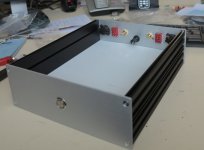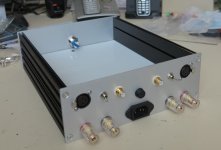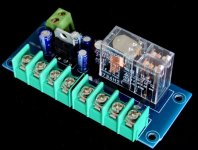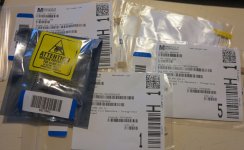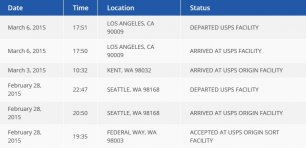For the same output level? Even if you reduce the input to get the same test output?
An increase in closed loop gain of 6 dB will reduce the loop gain by 6 dB, hence, the amplifier 'sees' 6 dB less error correction. This means any error signals, including distortion, will experience 6 dB less suppression, hence, be 6 dB higher. That's fundamental control systems theory right there...
Franco and Sedra/Smith cover this in detail. I suspect Jung does as well. For the full reference, see the Reference Texts section on my website.
National Semiconductor/TI's "Op-Amps for Everyone" is a handy reference as well. See Equation (5-7) in Chapter 5: http://www.ti.com/lit/ml/sloa077/sloa077.pdf
~Tom
Last edited:
Really nice to watch as people build these and listen. I've put my plan on the back-burner for now and opted for a much cheaper "summer amp". I suspect I will eventually build a Modulus-86, but my current budget simply cannot make it float. Keep up the great work everyone. I continue to watch in envy.
Hello,
The progress of my project in pictures:
The HIFI2000 case comes from another abandoned project.
The list of components ordered from Mouser USA was delivered in 48 hours in France.
The toroidal transformer (2x20V, 160VA) and some miscellaneous ordered from Audiophonics were delivered within 48 hours.
I am still waiting circuit boards ordered from Tom. They are shipped, but in transit through the US for more than a week ... So, no yet in France
I expect from China delivery of a protection module based on the chip upc1237.
I take this waiting to prepare the cabinet, already well advanced. Note the introduction of a double bottom that will help conceal part of the wiring.
To be continued ...
The progress of my project in pictures:
The HIFI2000 case comes from another abandoned project.
The list of components ordered from Mouser USA was delivered in 48 hours in France.
The toroidal transformer (2x20V, 160VA) and some miscellaneous ordered from Audiophonics were delivered within 48 hours.
I am still waiting circuit boards ordered from Tom. They are shipped, but in transit through the US for more than a week ... So, no yet in France
I expect from China delivery of a protection module based on the chip upc1237.
I take this waiting to prepare the cabinet, already well advanced. Note the introduction of a double bottom that will help conceal part of the wiring.
To be continued ...
Attachments
I think you are mixing the units. Distortion is measured in terms of the output signal. Not all distortion are respond linearly to outer loop gain. Anyway, I just wanted to know the reason you came up with those numbers. Not that it really matters to me.An increase in closed loop gain of 6 dB will reduce the loop gain by 6 dB, hence, the amplifier 'sees' 6 dB less error correction. This means any error signals, including distortion, will experience 6 dB less suppression, hence, be 6 dB higher. That's fundamental control systems theory right there...
Franco and Sedra/Smith cover this in detail. I suspect Jung does as well. For the full reference, see the Reference Texts section on my website.
National Semiconductor/TI's "Op-Amps for Everyone" is a handy reference as well. See Equation (5-7) in Chapter 5: http://www.ti.com/lit/ml/sloa077/sloa077.pdf
~Tom
Last edited:
- For mine, no comment ...My V1 boards seemed to have vanished into thin air. I had to request registered delivery for the V2 which Tom was kind enough to upgrade to Express delivery which took only about 3 days.
Attachments
Last edited:
Over the past 3-4 years, I've shipped about 300 orders to various destination, both international and domestic. The only board shipment I've ever seen disappear in the mail was the one to soongsc. It shipped January 6th, 2015 and hasn't been seen since...
Shipping to Western Europe generally takes 2-3 weeks. Shipping to Canada takes about a week or week-and-a-half, and shipping within the the US takes 3-7 days.
I will be more than happy to ship via Express Mail, but most customers balk at the $45 shipping cost. Express Mail arrives in a few days and is fully trackable. If you want even faster delivery, I'll be happy to ship via FedEx or UPS. The shipping fee will be over $100 for international destinations, but you'll have the boards tomorrow...
~Tom
Shipping to Western Europe generally takes 2-3 weeks. Shipping to Canada takes about a week or week-and-a-half, and shipping within the the US takes 3-7 days.
I will be more than happy to ship via Express Mail, but most customers balk at the $45 shipping cost. Express Mail arrives in a few days and is fully trackable. If you want even faster delivery, I'll be happy to ship via FedEx or UPS. The shipping fee will be over $100 for international destinations, but you'll have the boards tomorrow...
~Tom
Last edited:
I think you are mixing the units. Distortion is measured in terms of the output signal. Not all distortion are respond linearly to outer loop gain. Anyway, I just wanted to know the reason you came up with those numbers. Not that it really matters to me.
Definition: Total harmonic distortion (THD) is ratio of the sum of the powers of the harmonics to the power of the fundamental.
As long as we are talking distortion caused by non-linearities within the amp and the amp is operated closed loop and without clipping, the harmonic distortion components show up as an error signal within the loop and is attenuated by the loop gain.
There are distortion mechanisms where this does not apply. THD, however, is not one of them. The various transient-related distortions (SID, TIM for example) would be examples. However, in case of a well-designed amp, such as the Modulus-86, there is no appreciable transient-related distortion when used as an audio amplifier. The Modulus-86 can slew from rail-to-rail even with a single-sample rail-to-rail step at 192 kHz sampling rate (assuming any audio circuit was able to generate this).
~Tom
Last edited:
Hi Tom,
- I wait and see...
So another week to wait ...Shipping to Western Europe generally takes 2-3 weeks.
- I wait and see...
Definition: Total harmonic distortion (THD) is ratio of the sum of the powers of the harmonics to the power of the fundamental.
As long as we are talking distortion caused by non-linearities within the amp and the amp is operated closed loop and without clipping, the harmonic distortion components show up as an error signal within the loop and is attenuated by the loop gain.
There are distortion mechanisms where this does not apply. THD, however, is not one of them. The various transient-related distortions (SID, TIM for example) would be examples. However, in case of a well-designed amp, such as the Modulus-86, there is no appreciable transient-related distortion when used as an audio amplifier. The Modulus-86 can slew from rail-to-rail even with a single-sample rail-to-rail step at 192 kHz sampling rate (assuming any audio circuit was able to generate this).
~Tom
And distortion caused by nonlinearity such as hysteresis will show up as same regardless of output level? I cannot believe this.
Sent from my iPad using Tapatalk
And distortion caused by nonlinearity such as hysteresis will show up as same regardless of output level? I cannot believe this.
Are we still talking about audio amps? If you have hysteresis in your audio amp, you really should go back to the drawing board and redesign your amp.
~Tom
Resistor and capacitor inductance can hardly classify as air cored inductance. But I am just curious because when you see a distortion number, it could be caused by anything. Then there needs to be a series of other methods to find out what exactly that is.
Personally I praise your ability to achieve the low distortion numbers that you already done even though I have never used those numbers as a design criteria but rather a means to find the dominating issue throughout a system. Yes, I have used distortion numbers to reject a layout before, but first there was an audible difference between two same circuits detected first. I have also used various measurements which explained sonic differences between capacitors and used it as a means to prove that the supplier was not supplying the right capacitor they claimed to supply even though they looked exactly the same.
My interest is what kind of sonic qualities are associated with the published low levels of distortion. Would I like to see tests at different levels? Surely I would, I also felt that looking at input impedance curves of positive and negative inputs would be very helpful, since I have the boards now, this is one measurement I will be doing. It will take some time to get to it though. As I am going through a series of listening tests of another design which the reviewers are quite critical and each have different views.
Personally I praise your ability to achieve the low distortion numbers that you already done even though I have never used those numbers as a design criteria but rather a means to find the dominating issue throughout a system. Yes, I have used distortion numbers to reject a layout before, but first there was an audible difference between two same circuits detected first. I have also used various measurements which explained sonic differences between capacitors and used it as a means to prove that the supplier was not supplying the right capacitor they claimed to supply even though they looked exactly the same.
My interest is what kind of sonic qualities are associated with the published low levels of distortion. Would I like to see tests at different levels? Surely I would, I also felt that looking at input impedance curves of positive and negative inputs would be very helpful, since I have the boards now, this is one measurement I will be doing. It will take some time to get to it though. As I am going through a series of listening tests of another design which the reviewers are quite critical and each have different views.
Not sure what you hope to find. Within the power envelope of the device (no driving apogee scintillas with this) there is nothing in the distortion measurements that anyone could pick up in listening and any chasing lower numbers would be just for the technical challenge. Mod-86 is a 'don't fret just listen to clean power' design. Not much for anyone to tweek here.
Well, I doubt I will be doing any tweaking, but rather listen and understand what kind of sound will come out of this kind of a design. Certainly in combination with looking at measurements, I might just find some important aspects in association with listening impression.
- Home
- Amplifiers
- Chip Amps
- Modulus-86 build thread
